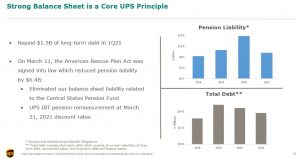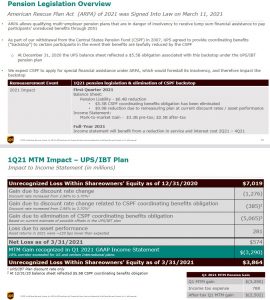Contents
I suspect many of us have equity holdings to which we pay little if any, attention. In my case, United Parcel Service, Inc. (UPS) is such a holding. On April 27, 2021, however, it released Q1 results and the share price closed ~$18 higher than the prior day's closing share price. This is puzzling since a change of this magnitude is highly unusual for UPS. Sure enough, while business conditions are improving, a significant factor for the jump in the share price is that UPS is reaping the benefits of the American Rescue Plan Act.
I am unable to locate investment account statements before 2006 but know UPS was a holding as early as January 2006. It is very possible I may have initiated my UPS position during the .com days (1999 - 2000). I did not have the intestinal fortitude to invest in any of the technology companies. I did, however, want to capitalize on the trend toward online shopping that would lead to higher package delivery volumes.
In my first UPS article I wrote on this blog I disclosed the purchase of additional shares. I wrote a follow-up article in February 2018 at which time I viewed shares as fairly valued but elected not to acquire additional shares. At the time of my 3rd article in February 2019, I once again viewed shares as being fairly valued but acquired no additional shares.
I have only made one small lump sum purchase (February 2017) after initiating my UPS position. I have, however, automatically reinvested the quarterly dividends. This explains why I now have over 35% more shares than at the time of my original purchase ~20 years ago. I mention this to demonstrate the impact automatic dividend reinvestment can have on an investment over a lengthy timeframe.
Business Overview
Most people are at least somewhat familiar with UPS but might be interested in learning about the company's history. Facts and figures regarding UPS' global presence are also available for review. Further links to company facts can be accessed here.
I always recommend an investor have a basic understanding of a business before initiating a position. A great source of information is the company's 10-K. The first section of UPS' 10-K includes a review of the company. An explanation of various Risk Factors follows the company review.
UPS Freight Divestiture
On January 25, 2021, UPS announced the signing of an agreement to sell UPS Freight to an affiliate of TFI International Inc.; the accompanying presentation is accessible here.
On the Q1 Earnings call, UPS' CEO indicates this transaction is set to close by the end of April 2021 for $0.8B before adjustments.
UPS Freight is the 5th largest U.S. LTL carrier. It specializes in moving smaller shipments from multiple customers via a network of consolidation terminals. UPS Freight's ~$3.15B of FY2020 revenue is only ~4% of the consolidated top line.
This divestiture fits with the CEO's 'better, not bigger' framework and should help reduce management distraction and boost attention on optimizing the UPS' core package delivery divisions. In addition, UPS Freight's asset-intensive trucking operations have been only marginally profitable in recent years with margins below that of key LTL peers (eg. FDX Freight, XPO, and Old Dominion).
Financial Review - Q1 2021 Results
I provide these links to UPS' Q1 results and the accompanying Earnings Presentation.
UPS is striving to be the carrier that shippers and receivers can count on for reliable delivery. As this relates to the COVID-19 vaccine, UPS' global expertise, technology and network are enabling it to move vaccines, kits and dry ice around the world. As of April 24, 2021, UPS delivered:
- more than 1.1 million shipments;
- ~196 million vaccine doses to ~50 countries and territories; and
- utilized UPS Premier Service to achieve 99.9% on-time delivery.
On the Q1 earnings call, management indicates key economic indicators continue to support a strong recovery in 2021.
The company's focus on bottom-line results drove strong cash flow in Q1. UPS generated $4.5B cash from operations and Free Cash Flow of ~$3.7B, a 130% YoY increase.
So far this year, UPS has distributed $0.938B in dividends.
In Q1, UPS repaid $1.5B of long-term debt maturities and in early April it repaid another $1B in debt thus achieving the 2021 target of $2.5B in debt repayment.
FY2021 Guidance
Due to uncertainty related to the pandemic and other factors that could interrupt the recovery, UPS is not providing revenue or diluted EPS guidance. Management does offer that:
- the sale of UPS Freight should close very shortly;
- $4B of Capital Expenditures are forecast;
- there are no plans to repurchase shares; and
- ~23.5% is the expected effective tax rate for the remainder of the year.
On March 11, 2021, the American Rescue Plan Act became law. This law protects certain multiemployer pension plans from becoming insolvent through 2051. This, in turn, eliminates UPS' balance sheet liability for potential coordinating benefits related to the Central States Pension Fund. The passage of the law triggered UPS to remeasure the UPS IBT pension plan at current discount rates, which have significantly increased since year-end.
The result is a ~$6.2B reduction in UPS' pension liability. This reduction and $2.5B in debt repayments reduce UPS' long-term obligations by $7.9B. Refer to the balance under the Pension and Postretirement Benefit Obligations line item on page 16 of 21 in the April 27, 2021 8-K).
Free Cash Flow (FCF)
The American Rescue Plan Act will greatly improve UPS' FCF going forward (refer to pages 17 and 18 of 21 in the April 27, 2021 8-K) where we see FCF of ~$3.7B in Q1 versus ~$1.6B in Q1 2020.
This reduction in the pension deficit is due to the reversal of a backstop liability related to UPS' withdrawal from the Central States Pension Fund in 2007.
Liquidity is strong and meaningfully lower CAPEX of ~$4B/year should hopefully enable the company to deploy FCF to improve investor returns.
Risk Assessment
Moody's - UPS' domestic senior unsecured debt was AAA in the .com days. The rating, however, is now A2. Following the release of Q1 2021 results, the outlook is 'stable' versus the prior 'negative'.
S&P Global - currently assigns an A- rating.
Moody's rating is 1 notch higher than that assigned by S&P Global but both ratings are upper-medium investment-grade ratings.
Both ratings indicate UPS has a STRONG capacity to meet its financial commitments. It is, however, somewhat more susceptible to the adverse effects of changes in circumstances and economic conditions than obligors in higher-rated categories.
UPS' credit risk is acceptable from my perspective.
Dividend and Dividend Yield
Looking at UPS' dividend history, we inconsistent dividend increases with a $0.19 quarterly dividend in 2001 - 2002 and $0.45 in 2008 - 2009.
More recently, we see that UPS increased its quarterly dividend from $1.01 to $1.02 with the first quarterly dividend of 2021.
Following the recent surge in UPS' share price to ~$194, the $1.02/quarter provides investors with a ~2.1% dividend yield. In contrast, the dividend yield at the time of my previous articles ranges from ~2.7% to ~3.45%.
The diluted weighted-average shares outstanding in Q1 2021 are 876 million.
For comparison purposes, UPS’s 2010 – 2020 diluted weighted average common shares outstanding are 1,003, 991, 969, 948, 924, 906, 887, 875, 870, 869, and 871.
Valuation
UPS's diluted EPS during 2010 - 2020 has been all over the map:
$3.33, $3.84, $0.83, $4.61, $3.28, $5.35, $3.86, $5.61, $5.51, $5.11, and $1.54.
Its valuation during the same timeframe has also been all over the map:
20.86, 17.30, 88.83, 66.93, 27.65, 22.02, 20.43, 29.20, 15.60, 20.36, and 31.95.
UPS generated $5.47 in Q1 diluted EPS but is not providing guidance for the remainder of the current fiscal year. Brokers are likely in the process of revising FY2021 diluted adjusted EPS estimates but for now, the estimates from 30 brokers are a mean of $10.22 and a low/high range of $7.22 - $12.35.
With shares trading at ~$194, we get an adjusted diluted PE range of ~15.7 - ~26.9. I think the windfall attributed to the American Rescue Plan Act makes it more likely that FY2021 adjusted diluted EPS will end up close to ~$10.30. On this basis, the forward adjusted diluted PE is ~18.8.
The sudden surge in UPS' share price from ~$176 to ~$194 on April 27, 2021, seems overdone to me and reinforces my opinion that many investors are being irrational. If UPS generates ~$10.30 of adjusted diluted EPS in FY2021 and UPS' share price retraces to ~$176, we get a forward adjusted diluted PE of ~17. In my opinion, a price below $176 represents a buying opportunity.
UPS - Reaping the Benefits of the American Rescue Plan Act - Final Thoughts
UPS is the world's largest package delivery company with a well-recognized global brand and a highly integrated, very difficult-to-replicate global network. The company has a new CEO and a new strategy with a greater focus on revenue per package and higher-margin operations and customer segments. The new CEO has also communicated to the investment community that UPS aims to increase productivity, improve asset utilization, and lower the asset intensity of the operations.
Amazon currently comprises ~13% of UPS' consolidated revenue. As Amazon continues to aggressively push the insourcing of its own last-mile delivery needs, this removes some incremental growth opportunities for UPS. Presently, however, Amazon still needs UPS’ capacity.
Based on my outlook, I am refraining from acquiring additional UPS shares at this point.
Stay safe. Stay focused.
I wish you much success on your journey to financial freedom.
Note: Please send any feedback, corrections, or questions to [email protected].
Disclosure: I am long UPS and FDX.
Disclaimer: I do not know your individual circumstances and do not provide individualized advice or recommendations. I encourage you to make investment decisions by conducting your own research and due diligence. Consult your financial advisor about your specific situation.




